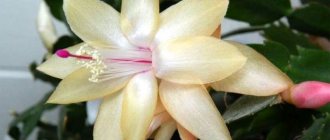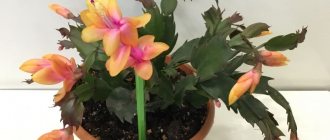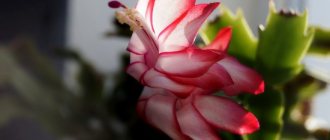In nature, there are cacti that are afraid of the sun, love water and have no spines. Such a cactus is called Schlumbergera, or Decembrist, or zygocactus. This plant is part of a genus of epiphytic South American cacti that grow on woody branches in tropical forests. Zygocactus blooms when there is a tropical summer in its homeland, namely in November or December, and flowering ends in the last days of January. Decembrist was brought to the middle latitudes in 1816 by the collector Allan Cunningham.
Brief description of cultivation
- Bloom . It is observed in winter, or more precisely, in December–January.
- Illumination . Slight shading or bright but diffused light. Windows with an eastern or western orientation are perfect, but if the pot is placed on a southern windowsill, then the flower will need shading during lunch hours.
- Temperature regime . Zygocactus is able to grow normally at temperatures from 18 to 40 degrees. But in summer, the flower grows and develops best at an air temperature of 18 to 22 degrees, and in winter - from 14 to 16 degrees.
- Watering . Moisten the soil mixture in the pot moderately after its surface has dried to a depth of 10–30 mm.
- Air humidity . It should be elevated. To do this, in the summer the bush must be moistened with a sprayer several times a week; in the winter months, the number of sprays is reduced to 1-2 every 30 days.
- Fertilizer . Feed the flower once every half month from March to September. To do this, use a mineral complex fertilizer for cacti.
- Rest period . It is observed in October–November.
- Transplant . Young bushes are replanted regularly once a year, adult plants are replanted less frequently, or rather, once every 5 or 6 years.
- Trimming . To form the crown of the bush, unnecessary segments are carefully torn off by hand.
- Reproduction . Cuttings and grafting.
- Harmful insects . Spider mites, scale insects and mealybugs.
- Diseases . Phythium, late blight, fusarium, and also damage by bacteria of the Erwinia group.
Application
As a rule, zygocactus is not used in a variety of areas. It is used as an ornamental plant and also as a useful source of oxygen and ozone. This plant will please the eye even of those people who do not like plants with colorful flowers. It can be safely given as a gift for New Year's holidays and birthdays to people who were born in the cold season.
Features of zygocactus
Decembrist differs from many house flowers in that it blooms at a time when most plants have a dormant period. Such a plant has other features that the gardener must know about:
- The flower is not recommended to be grown on windowsills of western and southern orientation, since due to too much bright light, the final fragments of the stems may begin to die off on the bush.
- In summer, the plant needs a large amount of fresh air. Therefore, at this time it is recommended to move it to a loggia, balcony or terrace, and you need to choose a place for it that is in the shade.
- In the summer, zygocactus responds very well to a warm shower. If you don’t have time for this, then at least systematically moisten the bush with a sprayer.
- If the Decembrist is provided with good care and suitable conditions for growth, then it will be able to grow normally and bloom regularly for 15–20 years.
- Schlumbergera is one of those flowers that it is better not to disturb during the formation of buds. The flower pot cannot be moved to another place or even rotated, as this may cause the buds to drop.
- If desired, zygocactus can be grown not only as an ordinary indoor flower, but also as an hanging plant.
How to make “Decembrist” bloom - Everything will be fine
Beneficial features
Schlumbergera.
Photo No beneficial properties of the flower were identified, nor any harmful ones. However, there is an opinion that the plant can still bring some benefits, with the exception of its beautiful appearance.
Flower growers believe that the Decembrist brings positive energy. Some note that in the house in which the plant appeared, the number of quarrels was reduced.
The flower itself also requires dedication from the owners. Schlumbergera loves when people talk to her and when she is praised for flowering.
It is also believed that the flower can ease allergic reactions and relieve insomnia.
Caring for the Decembrist at home
Watering and air humidity
The features of growing Decembrist under indoor conditions are radically different from those recommended for cultivating other cacti. Most of the care rules are similar to those that apply when cultivating ordinary deciduous houseplants. For example, if you forget to moisten the substrate in a pot with a cactus in time, then nothing bad will happen because of this. But the zygocactus should be watered systematically, and warm, well-settled water is used for this. It can also suffer due to too dry air in the room, so it is recommended to systematically moisten the bush with a spray bottle. You can also increase air humidity by placing a pot with a plant on a tray into which moistened pebbles are poured.
Illumination and temperature
Ordinary cacti tolerate direct sunlight well, but Schlumbergera can suffer greatly from it, so it requires mandatory shading. But it is not demanding on temperature, but grows and develops best during the growing season in cool conditions (from 18 to 22 degrees).
Fertilizer
They begin to feed the flower in March; for this purpose, complex mineral fertilizer for cacti is added to the soil mixture once a month, using half the dose recommended by the manufacturer on the packaging. In the summer, after the shoots begin to grow and develop intensively, the frequency of fertilizing is increased to twice every 30 days. With the onset of September, they stop adding fertilizers to the substrate. Experienced gardeners recommend systematically treating the bush with a fungicide solution to protect it from fungal diseases.
Trimming
Formative pruning of the flower is carried out in June. To do this, do not cut off the excess part, but carefully unscrew it by hand. As a rule, shoots that are too long, as well as those that grow incorrectly, are pruned. In addition to the fact that after pruning the bush looks more impressive, this also has a positive effect on its flowering, which becomes more luxuriant.
Decembrist transplant
Decembrist is replanted in the last days of February after it has completely faded. Young bushes are replanted once a year, and adult bushes are replanted once every 4 or 5 years. Since zygocactus has a superficial root system, a low but wide pot is used for planting it. A drainage layer is made at the bottom of the pot, the thickness of which should be equal to 1/3 of the height of the container. For replanting, use ready-made purchased soil mixture for cacti. In order to prepare the soil mixture with your own hands, you need to combine leaf and turf soil, as well as sand (2:1:1). Then a little expanded clay or brick chips are added to the mixture for looseness, as well as quite a bit of charcoal powder for disinfection. The resulting substrate should be slightly acidic.
Decembrist. Replanting into new soil. Experiment with pine bark.
Reproduction of the Decembrist
Most often, indoor zygocactus is propagated by cuttings. To begin with, you need to unscrew two or three outer “links” from the stem, after which they are left in the fresh air for several days, where they should dry well. For rooting, the cuttings are planted in a moistened substrate, and on top they are covered with a cut plastic bottle or a transparent glass jar. Place the cuttings in a shaded place and provide them with systematic ventilation and coolness (from 15 to 20 degrees).
Most often, propagation by cuttings is carried out after Schlumbergera has been pruned, since after this procedure a large number of finished cuttings may remain.
Reproduction of Schlumbergera. How to propagate Decembrist.
Reproduction methods
Homemade zygocactus is propagated by rooting cuttings. In spring or early summer, sections of stems with 2-3 leaves are cut. It is recommended to dip the cut area in crushed charcoal. The cuttings are dried in air for 1-3 days. When the cut site is covered with a thin film, the zygocactus can be planted in the soil. Use containers with sand or sand-peat mixture. There is no need to bury the cuttings. It is enough to install it vertically and create a support. When the roots appear, the seedlings can be carefully transplanted into separate small pots with soil for adult zygocacti.
Pests and diseases of the Decembrist
Diseases
Zygocactus may suffer from fungal diseases, for example, phytium, fusarium or late blight. The causative agents of these diseases can be found in a poorly prepared substrate, from which they penetrate into the flower, and the root collar of the plant is the first to be damaged. The affected bush becomes faded and has a grayish tint, and segments begin to die off. As a result, the flower begins to fade even with systematic watering. In order to get rid of fusarium, the Decembrist is treated with a solution of a special fungicidal agent, and if it is affected by late blight and phytium, the bush is sprayed with Topaz, Maxim or Vitaros.
Harmful insects
The appearance of a rusty coating on the surface of the bush may indicate that a spider mite has settled on it. It is a very small insect with a yellow, brown or pale red color that is almost impossible to see with the naked eye. Mites appear where there is very low air humidity for a long time. To destroy such a pest, the bush is sprayed with Fitoverm, Actellik or Neoron.
If you see white lumps between the stems that look like cotton wool, then this is a sure sign that mealybugs have settled on the flower. In order to get rid of them, treat the bush with Aktara solution.
Possible problems
If zygocactus is not properly cared for, problems may arise, for example:
- Wilting of the bush . The wilting of the plant may be due to the fact that it is affected by phytium or late blight. Also, shoots may become sluggish due to disease of the root system. If the trunk of the bush sways and has become unstable, this may be due to the fact that the roots of the flower have already died as a result of hypothermia (the room is too cold or the bush was watered with very cold water). The roots could also die because the pot overheated in the sun. A very high concentration of fertilizer solution can also severely damage the root system. In this case, the Decembrist is immediately transplanted into fresh soil mixture, otherwise the concentrated solution may completely burn the roots.
- Lack of flowering . Zygocactus will not bloom until it senses that it is time to bloom. For this to happen, the flower needs to be provided with a full period of rest. To do this, from the last days of September to the end of November, the plant is transferred to a cold room, during this time it is not fed and watered very rarely and with a small amount of water (make sure that the lump of earth in the pot does not dry out). In the last days of November, move the Decembrist to a warm and well-lit place, and begin to water it systematically. Rotate the bush regularly around its axis, thanks to this all its sides will be illuminated evenly. After the buds appear, do not allow the clod of earth in the pot to dry out, and do not turn or move the bush to another place, otherwise all the buds may fly off. If everything is done correctly, then the zygocactus will undoubtedly delight you with lush flowering.
- Dying and flying around of segments . In some cases, the leaves of a seemingly perfect healthy bush may begin to die and fall off. Most often, the death of segments is due to the fact that a spider mite has settled on the bush. If the pest was not found, then the “leaf fall” may be due to a lack of nutrients (too poor substrate or very infrequent feeding). In this case, the bush needs to be fed 1–2 times leaf by leaf with a fertilizer solution for epiphytic cacti, then it is added to the substrate. If, even after such feeding, the falling of the segments continues, then the plant will have to be replanted in a fresh soil mixture. If the terminal segments fly around, the reason for this may be excessively low air humidity or stress (change in environment, sharp fluctuations in daily temperatures, untimely transplantation or draft).
DECEMBER (Schlumberger) why do the leaves fall? Growing problems and plant diseases!
Benefit
Beliefs say that this type of cactus contains strong energy that is beneficial for the environment in which it is located. If you buy a “Decembrist” for your home or it is given to you as a gift, you can be sure that peace and grace will reign in your home. Zygocactus absorbs the energy of hostility and evil and not only destroys, but transforms them into good and good, reminding people of tenderness and care.
They say that even the most evil and aggressive people, being in a room where there is a “Decembrist”, become kinder, softer and more sympathetic. This conclusion can also be drawn from the fact that the plant is completely unpretentious. It doesn't need much care because it gives that care to you. But it is also important not to forget about the flower, enjoy its presence in your home and show the plant to guests.
The flower is considered environmentally beneficial. It increases the content of substances such as ozone and oxygen in the air. Thanks to this, the overall reactivity of the body increases and performance improves. The flower perfectly absorbs sounds, which allows you to muffle sharp sounds in rooms and not react to them too much.
Types of Decembrist with photos and names
Buckley
The Decembrist variety "Bakley" is considered the most persistent. It withstands changes of environment and some lack of care well. "Bakley" grows 40-50 centimeters, resulting in a large and lush bush. The Decembrist variety has large buds. They can reach eight centimeters in length.
Decembrist flower variety "Bakley" is distinguished by a variety of colors. They can be of different colors. But the leaves are always dark green.
This zygocactus blooms from November to March. Such a long period of bud formation cannot but please.
White
Decembrist variety “White” looks very gentle and at the same time elegant. Usually such a plant blooms profusely. Sometimes the stems and leaves are not visible under the buds. "White" has large flowers.
Truncated
This species of zygocactus is characterized by light green, pointed leaves and a variety of flowers. The stems of the plant reach six centimeters and have teeth on the edge.
Decembrist flowers “Truncated” are two-tiered. They have petals bent back. The colors of this zygocactus are very diverse. The buds can be purple, white, pink, orange or a combination of colors. That is why this variety is especially popular.
Rousseliana
This Decembrist grows no higher than thirty centimeters. Its leaves are flat and glossy. It is worth noting that this variety of zygocactus does not have needles, which makes it very cute. The peduncle tube of this plant variety is green. The buds themselves can be red, pink, purple. The short stature and abundance of colors make the Rousseliana variety very attractive. He can decorate any room.
It is also resistant to negative environmental factors. This makes it popular among the population, because the unpretentious plant is easier to care for.
Golden Cream
This Decembrist variety is very interesting. The fact is that it has yellow inflorescences. Moreover, their shade is gentle and pleasant, just like sunny. It is worth noting that in nature Decembrists do not bloom yellow. But the breeders tried their best and developed this species. They had to work for a long time, the task before them was not an easy one. Still, they managed to create a warm, sunny Decembrist.
Aspen
This zagocactus is double. It blooms white and pale pink. The stamens of the plant are yellow. Decembrist of this variety is a bit like a carnation when flowering. He looks very solemn. It is good to place such a plant in a room where there is a lot of space and the flower can appear in all its glory.
General information about the plant
Decembrist is a bright ray of light that creates the mood for an apartment and office in frosty weather. The beginning of the flowering period coincides with the beginning of winter. Zygocactus Schlumbergera produces long, multi-layered buds with curled petals. Shades range from deep crimson, hot pink to white-cream and soft purple. The sepals have the same shade as the petals.
The leaf plates are complex, consisting of numerous “segments” similar to crayfish necks, hence the popular name of the popular flower. Greens of different shades - from rich to light green. Most varieties have dense, fleshy leaves 3–5 mm thick. The length of the shoots, consisting of flat segments, sometimes reaches 1 m. Branching, drooping stems with buds at the end form an elegant “structure” around the flowerpot.
Unlike other types of cacti, the Christmas tree does not have spines.
Common names for Zygocactus Schlumberger:
- Decembrist,
- Christmas,
- cancerous cervix.
The birthplace of the Decembrist is South America. In subequatorial forests there is a lot of heat and light, optimal humidity, which creates excellent conditions for the growth of a spectacular flower. Despite such remote native lands, the Decembrist has taken root well in regions with a temperate climate.
Important details:
- the flower is suitable for growing in office and residential premises with a normal microclimate. The positive point is that there is no need to create excessive, high humidity or adhere to a temperature regime that causes discomfort for a person. Enough light shade, good watering, lack of heat in the room;
- acclimatization affected the optimal conditions for the growth and development of zygocactus. Often, a strong, healthy Decembrist flower produces buds every year and grows well even on a window on the east or west side, with enough light.
Zygocactus is several varieties of highly decorative plants. Each variety has a characteristic shape and size of inflorescences, original shades, and leaf blades of greater and shorter length. One thing is constant - during the flowering period, the Decembrist cannot be disturbed, otherwise the buds will fall off.
Popular types of cervical cancer:
- Zygocactus Rousseliana. A fairly low bush (up to 30 cm in height), shoot length: 80 cm - 1 m, the edges of the leaf blades are wavy, tubular flowers, of various shades;
- truncated zygocactus. Flower height - up to 50 cm, large buds - from 6 to 8 cm, petal shades: crimson, lilac, deep pink. The segments on the leaf blades are medium in size, the edges are serrated. A common type in offices and residential premises;
- Zygocactus Buckley. Large buds (about 8 cm), petals of pink and purple flowers, the edges of the plates are slightly pointed, the shade of green is lighter than that of other varieties. The height of the ornamental plant is from 40 to 50 cm.
In nature, scientists have identified six species of zygocactus.
Numerous hybrid varieties with original shades of petals have been bred for growing at home and in the office. With good care, the Decembrist flower pleases its owners for about 25–30 years with its spectacular appearance and delicate buds. On a note! Decembrist is similar to another type of cactus - ripsalidopsis. The main differences of the Christmas tree: pointed, pronounced protrusions of leaf plates-segments, the flowering period occurs in November - end of January. Another difference is that the flower is tubular at the base, and not star-shaped, like in ripsalidopsis.
Landing algorithm
Zygocactus is a flower that can be cared for at home to prolong its life; it is best to plant it in the spring.
Zygocactus flower: growing from cuttings
If propagation is carried out by cuttings, then after preparing the planting material, the algorithm of actions will be as follows:
- When a film begins to appear on the cutting, it must be placed in the previously prepared soil mixture.
- To make roots appear faster, you can cover the pot with plastic. However, in zygocactus the rhizome begins to develop very quickly, so this procedure is not necessary.
- All that remains is to water the cuttings.
Some do it even simpler (as when propagating violets from leaves). To do this, the cutting is simply lowered into a container with water, which should reach the lower segment. After this, you need to wait until the roots begin to develop from it, then you can plant the cutting in the ground, deepening it 2-3 cm.
To prevent the young cactus from falling over, it is additionally recommended to install a support and tie it up. Once the plant has taken root, the support can be removed.
Zygocactus seeds are collected from the fruits of the plant
If cactus seeds are used, it is recommended to plant them from May to June, for this:
- Seeds disinfected in potassium permanganate must be placed on the ground and lightly sprinkled.
- After this, it is better to cover the pots with seeds with polyethylene. The film must be removed periodically to prevent the formation of excess moisture and mold. Young plants also need oxygen.
- At the next stage, you need to place the container with germinating seeds on a windowsill or in another bright place and wait 1.5-2 months until the young cacti develop.
How to choose the right soil?
Ordinary garden soil is not suitable for rooting and growing Schlumbergera . A special substrate for cacti can be purchased at a specialized flower shop. Its main components will be river sand, humus from leaves and turf, peat and all the necessary nutrients.
If it is not possible to purchase this mixture, then you can prepare it yourself: coarse river sand, garden soil, peat, combine in a ratio of 1:1:0.5. You can add some crushed dry leaves and foam balls, brick chips or vermiculite. Another option: turf soil, sand, peat, leaf soil in the ratio 1:1:1:2, respectively.
Don’t forget about the essential component of the internal filling of the pot – drainage. Drainage is a layer of certain materials that helps drain excess water during irrigation. As a drainage layer, you can use expanded clay, pebbles, small stones, broken brick or brick chips, broken polystyrene foam, and pre-cut wine corks.











